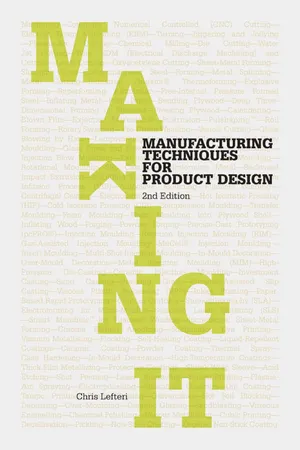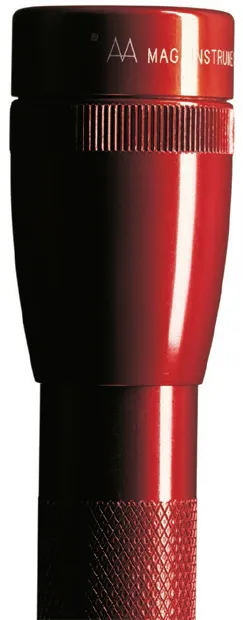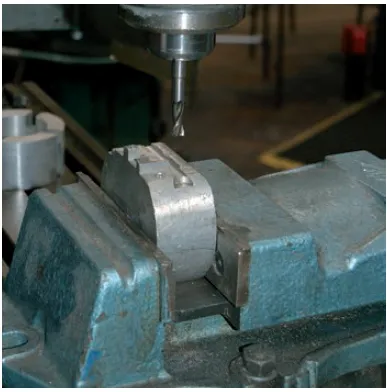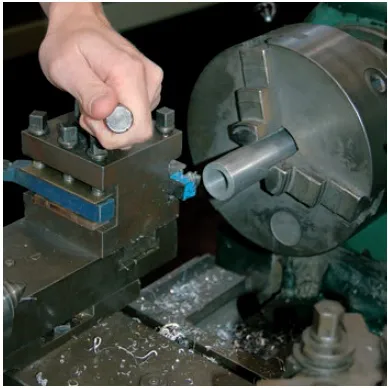![]()
1:
Cut from Solid
Machining
Computer Numerical Control (CNC) Cutting
Electron-Beam Machining (EBM)
Turning
Jiggering and Jollying
Plasma-Arc Cutting
The use of cutting tools to sculpt materials
This chapter encompasses some of the oldest processes used in the manufacture of objects, and these processes can be quite simply categorized by the fact that they use tools that cut away, shape, and remove material. Increasingly, the “brutal” part of these processes is being performed by automated CAD-driven machines, which carve effortlessly through most materials, providing yet another avenue for the exploitation of rapid prototyping technology and the replacement of the craftsman who gave life to many products throughout history.
Machining
including turning, boring, facing, drilling, reaming, milling, and broaching
Product | Mini Maglite® torch |
Designer | Anthony Maglica |
Materials | aluminum |
Manufacturer | Maglite Instruments Inc. |
Country | USA |
Date | 1979 |
The Maglite® torch, with its highly distinctive engineered aesthetic, has been produced using a number of metal chip-forming techniques, notably turning. The textured pattern for the grip, however, is produced post forming using a process known as knurling.
Machining belongs to a branch of production that falls under the commonly used umbrella term “chip-forming” (meaning any cutting technique that produces “chips” of material as a result of the cut). All machining processes have in common the fact that they involve cutting in one form or another. Machining is also used as a post-forming method, as a finishing method, and for adding secondary details such as threads.
The term “machining” itself embraces many different processes. These include several forms of lathe operation for cutting metals, such as turning, boring, facing, and threading, all of which involve a cutter being brought to the surface of the rotating material. Turning (see also p.20) generally refers to cutting the outside surface, while boring refers to cutting an internal cavity. Facing uses the cutter to cut into the flat end of the rotating work piece. It is used to clean up the end face, but the same tool can be used to remove excess material.
Threading is a process that uses a sharp, serrated tool to create screw threads in a predrilled hole.
Drilling and reaming are generally also lathe operations (though they can also be done on a milling machine, or by hand), but they require different cutters. As with all lathe operations, the work piece is clamped in the center of a rotating chuck. Whereas drilling is a straightforward operation to create a hole, reaming involves enlarging an existing hole to a smooth finish, which is done with a special reaming tool that has several cutting edges.
Other machining processes include milling and broaching. Milling involves a rotating cutter, similar to a drill, which is often used to cut into a metal surface (though it can be applied to just about any other solid material). Broaching is a process used to create holes, slots, and other complex internal features (such as the internal shape of a spanner head, after it has been forged, see p.187).
1 A very simple setup for milling a chunk of metal. The cutting tool, which resembles a flat drill bit, can be seen fitted above the clamped work piece.
2 A straightforward setup for a lathe operation in which the tube of metal to be cut is clamped into a chuck. The cutter is poised ready to make a cut.
– Very versatile in terms of producing different shapes.
– Can be applied to virtually any solid material.
– High degree of accuracy.
– Can be slow.
– Parts can be restricted to the stock sizes of material used.
– Low material utilization due to wastage when cutting.
Volumes of production
These vary according to type, but computer numerical control (CNC)-automated milling and turning production involves several cutters working on several parts at the same time, which can result in reasonably high volumes of production. This large collection of techniques also includes hand machining of individual components.
Unit price vs. capital investment
In general, there are no tooling costs involved, but the mounting and unmounting of work from the machine reduces production rates. However, the process can still be economical for short runs. CNC-automated milling and turning use CAD files to automate the process and produce complex shapes, which can be batched or mass-produced. Although standard cutters can be used for most jobs, specific cutters may need to be produced, which would drive up o...






